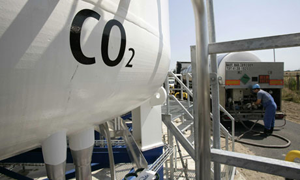Why carbon capture must shed its image as an 'unproven' technology
on
Why carbon capture must shed its image as an ‘unproven’ technology
It’s up to technologists to refine CCS, independently of policy and funding, in order to accelerate the sector. Winning EU funding is rarely without its obstacles, even for a technology such as Carbon Capture and Storage (CCS), which has the potential to transform fossil fuels into a low carbon energy source. However, CCS is too important for technology vendors to sit back and wait for policy to support it, the industry needs to take a proactive approach to improving the appeal of CCS, from the inside out.
 |
| (c) www.guardian.co.uk / Sipa Press/Rex Features |
For example, at the end of last year, the NER300 fund of €1.2 billion originally set aside for CCS, from the auctioning of carbon allowances under the emissions trading scheme (ETS) was instead allocated to renewables. This decision does not represent a policy shift from the European Commission; Connie Hedegaard, European Commissioner for climate action, expects CCS plants to qualify for funding in the next round. Also, the EC has proposed to move beyond ETS and introduce new mechanisms such as Emission Performance Standards or a CCS certificate system. It does highlight, however, that unless CCS technology advances, its perception as an ‘unproven’ technology, will continue to create further blockages for funding.
Price alone does not trigger innovation
Energy companies have been capturing and transporting CO2 gases in large-scale plants for decades; which has been utilized in enhanced oil recovery, as well as the production of carbonated drinks. But the fact remains that unlike other now mainstream low-carbon technology sectors, such as wind and solar, CCS technologies do not currently exist at commercial scale. Currently, carbon capture is costly; the GCCSI estimates that each Mwh supported by CCS costs energy generators an additional $50 - $100, as well as substantial capital costs for development.
Of course stimulation of a full scale CCS market will to a large extent be sparked by an adequate carbon floor price being set.
| The CCS industry must push forward the advancement of technology |
Certainly the rewards are there for those countries and generators that invest, in terms of jobs created in this new industry. In the UK for example, a leader in CCS, research by the Carbon Trust found that CCS industrial development could contribute £3-16bn to UK GDP cumulatively to 2050. Furthermore, as well as enabling generators to benefit from the rise in cheap unconventional energy, such as shale gas, CCS allows countries to simultaneously avoid penalties for missing legally binding carbon targets. So, how can CCS advance to live up to its promise, whilst presenting itself as a viable technology that appeals to the short to medium term lens governments are permitted to exact on the low carbon economy?
Advanced technology required
Technology testing is the vital route for verifying and demonstrating capture technology, which in turn can reduce costs, plus technical, environmental and financial risks, thereby creating the preconditions for CCS success. The UK Energy Research Council (UKERC), which spent two years researching the means for establishing CCS as a mainstream technology, came to the same conclusion: a regulatory approach making CCS compulsory in all fossil plants will only work if the technology is more advanced. By bringing costs down and making the market viable, technologists provide a basis for global energy policy and investment.
To meet the need for testing, test centers have been developed on a major scale; allowing the safe simulation of carbon capture. CO2 Technology Centre Mongstad is the most advanced of these, offering the ability to capture 100,000 tons of CO2 a year,
| Collaboration is another key of testing carbon capture technologies at scale |
Collaboration is another key benefit of testing carbon capture technologies at scale. Recently, the world’s first international test center network for carbon capture test facilities was launched, to share knowledge and accelerate the commercialization of technology. The key aims of the network are diverse: to share technological developments, construction and operational experience, establish performance indicators, promote technology certification and standardization. For the first time, a collaborative playing field has been established allowing technologists to advance technology innovation, secure public support for and develop awareness of CCS benefits.
What this activity shows is that the CCS industry must push forward the advancement of the technology. Government, industry and investors must work together to build the essential demonstration projects over the next few years. But first, government and investors have to believe there is a market for CCS. To secure confidence from the EU and other funding sources, it’s up to technologists to demonstrate the commercial reality of CCS. While governments finalize CCS incentives and competitions, CCS testing helps win ongoing investment, as well as to build a demand for the technology, so that CCS-led regulations and policy making can have maximum impact. It’s a difficult and at times thankless task for generators, but until Government aligns with enterprise on CCS, they must continue with RD&D to reduce cost and risk. Our experience and that of the generators that use the facilities at Mongstad is, ‘build it and investment will come.’
|
Tore Amundsen is CEO of Gassnova (co-owner of Technology Centre Mongstad). |


Discussion (0 comments)